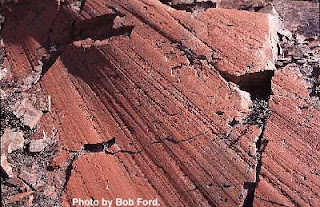Glacier National Park has a very unique and breathtaking landscape. This landscape is formed from the many processes that I have previously discussed in this blog. These forms and processes caused from glacial erosion help create the unique mountain faces, valleys, peaks, and lakes that define Glacier National Park and attract visitors from across the world. Aside from its unique physical features Glacier National Park also has a very unique climate. The west side of the park tends to be the warmer and wetter side of the park as it typically receives air currents from the Pacific Ocean and the Eastern side of the park tends to be drier and colder as it typically receives air currents coming off the Great Plains. This extreme weather is because of its rapid changes in elevation and its location along the Atlantic-Pacific Divide and the Continental Divide.
Over the course of earths history scientists have discovered that the earth moves in and out of glacial periods. This phenomenon is described as the glacial-interglacial yo-yo effect.
(A Graph showing the changes in Earths temperatures dating back 450,000 years ago)
A glacial period is described as when the earth is covered in glacial formations and an interglacial period, such as today, is when the earth is covered in less ice/glacial formations. It is the shift from glacial to interglacial that has created many of the unique landscapes found in Glacier National Park today. Because these sheets of ice will continue to move and reshape Glacier National Park, the physical features of the park will continue to change over a period of time. These processes that redefine the physical features of Glacier National Park do not happen overnight though, it is a long process. Glacier National Park has experienced some of the fastest glacial retreats in the world, hence its rapidly changing features. A study by NOAA says that because global warming is a natural cycle that can be perpetuated by human activity, specifically carbon monoxide levels, but not caused by human activity this glacial retreat is unstoppable for the next 1,000 years. This is proposing that the glaciers in GNP will continue to retreat and cause mass erosion creating deeper valleys, sharper peaks, and more variations between rougher and smoother rock faces. The retreat of these glaciers will also lead to an increased flow of glacial water in the area creating bigger rivers, canyons, and valleys as well as possible erosion caused from floods and mudflows.
(This Image depicts the predictable erosion and damage that many of the valleys in Glacier National Park could experience)
A study done by NOAA also states that if we humans do start taking intense actions on carbon-monoxide regulations in an attempt to slow down the effects of global warming, these glaciers will not be entirely gone in 1,000 or even 10,000 years.
Glacier National Park is located along the Lewis Over Thrust Fault. Because of this many of the changes that will occur in the landscape once most of the glacial ice has retreated will be more related to fault activity then glacial erosion. In the next 100,000 years the Lewis Overthrust Fault will continue to move older sediments and rock forms over newer sediments of rock.
This process will force younger rock slabs deeper into the earths core.
 If the rock slabs move far enough they will begin to create volcanic activity and we could see the landscape of what was once Glacier National Park become volcanic. Glacier covered volcanoes can create a catastrophic environment as volcanic eruptions melt glaciated areas creating destructive mudflows and floods.
If the rock slabs move far enough they will begin to create volcanic activity and we could see the landscape of what was once Glacier National Park become volcanic. Glacier covered volcanoes can create a catastrophic environment as volcanic eruptions melt glaciated areas creating destructive mudflows and floods.
Following this volcanic period, an article by the National Geographic declares that in 1,000,000 years much of Canada and the Northern Hemisphere will be covered in large sheets of ice as the next Ice Age should be in its early stages. In the last 3 million years earths climate has experienced dozens of ice ages, typically lasting around 41,000 years. But in the last million and a half years the length of the typical ice age has lasted closer to 100,000 years. This means that if the length of ice ages continue to grow and grow, in one million years from now what was once known as Glacier National Park will most likely be covered entirely in thick sheets of ice.
It is important to understand that the Earth does cycle in and out of glacial and interglacial periods and the processes discussed in this blog entry are sophisticated guesses of what the climate and landforms of Glacier National Park will look like in extreme conditions. That being said Glacier National Park will also move in and out of glacial and interglacial periods that will change the landforms seen today, preserve the landforms yet to be created, and then destroy and rebuild new landforms in what was once known as Glacier National Park.
References:




















